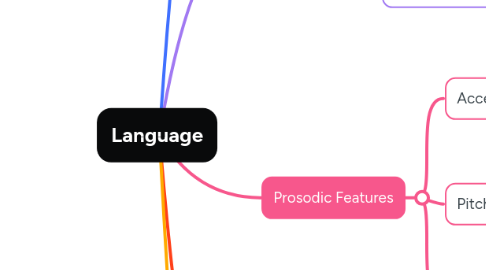
1. Myths
1.1. Primitive languages
1.1.1. "The most common misconception is the belief that unwritten languages are "primitive"...(Stanlaw, Adachi, Salzman, 2018, pg.3).
1.1.1.1. Primitive refers to the language associated with societies. For instance, one culture believe their language is better than others and so considers other languages as obscure and "ugly".
1.2. Grammar
1.2.1. Grammar means proper uses of punctuation marks, sentence structures, tenses, reduplication, and vocabularies in written and spoken languages that includes past, future, and present events.
1.2.1.1. Some think that languages of peoples whose societies are not urbanized and industrialized have "little grammar"...(Stanlaw, Adachi, Salzman, 2018, pg.4).
1.3. All languages the same?
1.3.1. https://youtu.be/WhFY8WZQZwA
1.3.1.1. Language means a form of human communication that involves structured words, gestures, written, and speech in social groups. Language is complex and have special characteristics and personalities.
1.3.1.1.1. ..."this does not mean that all languages are the same, do all things in the same way, or are equally influential in the modern transitional world ... (Stanlaw, Adachi, Salzman, 2018, pg.5)
2. Theories
2.1. Structural Linguistics
2.1.1. "The important is that signs between and within languages contrast with one another." (Stanlaw, Adachi, Salzman, 2018, pg.21)
2.1.1.1. Visioned language as consisting of large arbitrary signs. Developed tools to find rules and patterns that control the language system which includes phonology, morphology, syntax, and lexicon.
2.2. Chomsky's Transformational-Generative Grammar
2.2.1. "Thus, each native speaker possessed in his or head competence in all the aspects of how that language operates." (Stanlaw, Adachi, Salzman, 2018, pg.21).
2.2.1.1. Revealed that all languages share similarities which he called universal grammar. I-language is internalized and intensional knowledge that represents the speaker's language. E-language implied that speech is produced by speaker's external conditions.
3. Prosodic Features
3.1. Accent
3.1.1. "Additional features are essential for an utterance to sound natural and to be fully meaningful, especially stress and pitch, these two sometimes lumped together under the term accent." (Stanlaw, Adachi, Salzman, 2018, pg.55).
3.1.1.1. It is how a person pronounce and emphasize words and phrases. It is also bundled together with pitch. It can be distinctive in some languages.
3.2. Pitch
3.2.1. Pitch is defined as a distinctive level of tone associated with a syllable. It is also considered as a highness and lowness of a tone.
3.2.1.1. "By contrast, the use of pitch in English is not associated with individual syllable , but rather with utterances in a variety of intonation patterns."(Stanlaw, Adachi, Salzman, 2018, pg.56.)
3.3. Length
3.3.1. "For a linguistic anthropologist, acquaintance, with the methods of linguistic analysis and appreciation of structural differences among languages are essential." (Stanlaw, Adachi, Salzman, 2018, pg.56.)
3.3.1.1. Length refers to the elongation of a sound which is determined by the difference between the variation of the vowel sounds whether it is a short vowel or a long vowel.
4. Morphological Process
4.1. Derivation
4.1.1. Derivation refers to as a process of changing an existing word and forming new words such as affixes. For example, the word kind to kindly (new word).
4.1.1.1. "Some morphological process, however, are quite common throughout the world, even though they may be applied differently in specific languages." (Stanlaw, Adachi, Salzman, 2018, pg.73)
4.2. Inflection
4.2.1. "As languages go, English has very few inflectional affixes compared with, for example, Latin"(Stanlaw, Adachi, Salzman, 2018, pg.73)
4.2.1.1. Inflection is the use of affixes to demonstrate grammatical relationships that includes: adjectives, possessives, comparatives and superlatives, plurals, number, case, tense, verbs, and nouns.
4.3. Case forms
4.3.1. Case forms are an elaborate grammatical inflectional system that marks a word’s abilities in a sentence, such as plurals, singular, interrogative pronoun, personal pronouns, and adjectives.
4.3.1.1. "In other languages, however, cases are an important and elaborate grammatical feature." (Stanlaw, Adachi, Salzman, 2018, pg.74).
4.4. Aspect
4.4.1. "Whether or not a language formally marks a particular grammatical category does not make it superior (or inferior) to others." (Stanlaw, Adachi, Salzman, 2018, pg.74)
4.4.1.1. Aspect is a grammatical category that expresses how verbs are related to time in which as when in time a specific action was done during that time.
